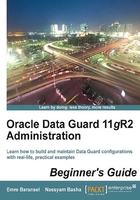
Time for action – searching for and fixing any table row uniqueness problem
- In order to check for any table row uniqueness, we can run the following query on the primary database:
SQL> SELECT * FROM DBA_LOGSTDBY_NOT_UNIQUE; OWNER TABLE_NAME B ------------------------------ ------------------------------ - SCOTT BONUS N SCOTT SALGRADE N SH SALES N SH COSTS N SH SUPPLEMENTARY_DEMOGRAPHICS N
This query was run on a newly created 11g release 2 database, which only includes built-in example schemas. The output shows that several tables from
SCOTTandSHschemas have row uniqueness problem.The
BAD_COLUMNcolumn has two values, which areYandN. If you see the rows withBAD_COLUMN=Y, it means that the table column is defined using an unbounded data type, such asLONGorBLOB. If two rows contain the same data except in theirLOBcolumns, the replication will not work properly for this table. If the application ensures the rows are unique, we should consider adding a disabled primary keyRELYconstraint to these tables. WhenRELYis used, the system will assume that rows are unique and not validate them on every modification to the table. This method will avoid the overhead of maintaining a primary key on the primary database. However, if there's no such uniqueness, we must add a unique-constraint/index to the columns on the primary database.BAD_COLUMN=Nmeans that there is enough column information to maintain the table in the logical standby database; however, the transport and apply services will run more efficiently if you add a primary key to the table. We should again consider adding a disabledRELYconstraint to these tables. - Let's add a disabled primary key
RELYconstraint to theBONUStable in theSCOTTschema. First we check the columns of the table using the following query:SQL> DESC SCOTT.BONUS Name Null? Type ----------------- -------- ---------------------------- ENAME VARCHAR2(10) JOB VARCHAR2(9) SAL NUMBER COMM NUMBER
- Now we add the disabled
RELYconstraint to theENAMEcolumn of the table:SQL> ALTER TABLE SCOTT.BONUS ADD PRIMARY KEY (ENAME) RELY DISABLE; Table altered. - We can check the
DBA_LOGSTDBY_NOT_UNIQUEview again to see if theBONUStable has disappeared from the list using the following query:SQL> SELECT * FROM DBA_LOGSTDBY_NOT_UNIQUE; OWNER TABLE_NAME B ------------------------------ ------------------------------ - SCOTT SALGRADE N SH SALES N SH COSTS N SH SUPPLEMENTARY_DEMOGRAPHICS N
- We should add disabled
RELYconstraints to the rest of the tables above. Now we're ready for the next step, which is creating the logical standby database.
What just happened?
We've just seen the prerequisite steps to create a logical standby database configuration. The first step was checking the unsupported tables that will not be replicated, in order to be aware which data will be missed on the logical standby and to decide whether to use the logical option or not. The next step is searching for and fixing any table row uniqueness problem, for properly working redo transport and SQL Apply services.